What To Expect From FUT Hair Transplant
Here's a write up on FUT hair transplantation. Who all can go for the treatment? Know all about it.

Is FUT Reliable For Everyone?
When you have made the ultimate decision and done your homework with due diligence, researched the options, talked to friends with similar hair transplant procedures, conferred with several local doctors and chose one, this is your first step for hair transplant.
Going for a consultation, discussed the current health status, expectations for hair restoration surgery, the financial options taking a few days off from work, this is what you need to take before going for that ultimate makeover in hair transplantation.
To enhance the appearance and well being and ready for the hair restoration procedure in case you have committed the procedure known as follicular unit transplantation or FUT.
It is important to find a surgeon dedicating his time for you whereas a doctor managing more than a few surgeries at the same time is a red flag as not only are you possibly being neglected, but the hair follicle tissue that is time-sensitive are being neglected as well.
A good night’s sleep is necessary before the day of surgery and abstaining from alcohol, aspirin, and Vitamin E as well as wearing an old button-down shirt that you can remove without pulling it over your head.
Days 1 - 10
The D-day is on and the procedure normally takes 4-5 hours to complete that is typically done in the physicians' office with a surgeon and a team of assistants.
Arrive early for your appointment to relax, check-in and feel confident that the decision and realistic goals have been in conjunction with the physician mitigating any disappointments and frustrations arising due to unrealistic expectations.
To gain an appreciation of what to expect over the coming 12 months, discuss and understand your options and outcomes with your surgeon.
To ensure your comfort during the procedure, the physician and his team are all set to do everything.
There may be pain and minor discomfort once the effects of the local anesthesia have diminished, and the doctor is sure to prescribe analgesics to relieve this pain.
Rest for 10 days as you may experience short–term numbness in areas affected on the scalp that is sure to wear off soon.
To minimize swelling, sleep with your head elevated or sit up in a recliner chair.
On the third day, there is bound to be mild swelling in the forehead area sure to dissipate over the next three days. It is normal to develop small blood lots at the incision sites and usually flake off in 5-7 days.
Start washing the hair gently on the 3rd day and regularly after the first week.
Days 10 - 14 Post-Op
Go back to the doctor’s office to have your staples and sutures removed 10-14 days is the surgery.
The transplanted hairs may shed at the 3-week mark, as a part of the lifecycle of the grafted hairs.
Although it may still look unsightly, at his point, the scalp should be healing well as people heal at different rates depending on a variety of factors including health. Those who smoke, suffer from diabetics as well as the elderly may heal more slowly than other patients.
1 - 3 Months Post-Op
Most patients have approximately 25% of new hair growth in the affected areas 1-3 months after the transplant surgery. Even though the new hair may not grow evenly, over time it will all grow in and thicken.
There’s nothing to panic if the head looks like it has developed acne as these are the new hair pushing up through the scalp and should be a cause for cheer.
5 - 6 Months Post-Op
Up to 50%o new hair growth will be visible by the 5th or 6th -month post-procedure. The hair shaft is sure to thicken as the new hair will be approximately 2-3 inches in length.
Minimize sun exposure and avoid strong chemicals such as hair dyes or perms as a precaution to protect new hair growth.
8 - 10 Months Post-Op
You will see the most impressive difference at the 8-10 month milestones since the initial surgery. At this instance, the hair growth should be at 80% and the hair will be longer, thicker and denser.
As the rate of each individual’s hair growth is unique to that individual, these are approximate rates that can be affected by smoking, age, and health status.
One Year Post-Op
You should have the head of hair you paid for at the one year anniversary or at least 90-100% of expected hair growth. The new growth may probably continue well past the one year mark.
Conclusion
As many patients request additional density to achieve their desired results, consulting a doctor helps decide whether additional surgeries are advisable. With the right treatment, the new hair is yours for the rest of the life that can be cut, styled and washed according to preference where no special regimen is required. To enjoy your new head of hair, book an appointment with a high-concept stylist.
What's Your Reaction?





















